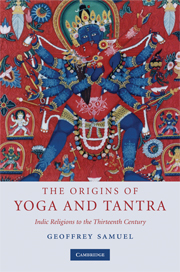Book contents
- Frontmatter
- Contents
- List of figures
- Preface
- 1 Introduction
- 2 Stories and sources
- PART ONE MEDITATION AND YOGA
- 3 The Second Urbanisation of South Asia
- 4 Two worlds and their interactions
- 5 Religion in the early states
- 6 The origins of the Buddhist and Jaina orders
- 7 The Brahmanical alternative
- 8 Interlude: Asceticism and celibacy in Indic religions
- PART TWO TANTRA
- References
- Index
5 - Religion in the early states
Published online by Cambridge University Press: 05 June 2012
- Frontmatter
- Contents
- List of figures
- Preface
- 1 Introduction
- 2 Stories and sources
- PART ONE MEDITATION AND YOGA
- 3 The Second Urbanisation of South Asia
- 4 Two worlds and their interactions
- 5 Religion in the early states
- 6 The origins of the Buddhist and Jaina orders
- 7 The Brahmanical alternative
- 8 Interlude: Asceticism and celibacy in Indic religions
- PART TWO TANTRA
- References
- Index
Summary
I begin this chapter with an overview of evidence about South Asian religion before 500 BCE. This discusses both archaeological evidence, mainly relating to the Indus Valley urban tradition and textual sources relating to the early religion of Indo-Aryan speaking peoples. In subsequent sections, I look at the development of Vedic-Brahmanical religion in the Kuru-Pañcāla region, and at other aspects of early Indian religion, particularly the religion of local gods and spirits
ARCHAEOLOGICAL SOURCES FOR EARLY INDIC RELIGION
I have already provided some discussion of religion in the Indus Valley cultural tradition in Chapter 1. I suggested there that while there are certainly features of the Indus Valley material that might be interpreted in terms of continuities with later periods, we know very little for certain. The evidence is capable of many interpretations, and analyses are so heavily dependent on reading later practices and concepts into the material that they are of little help in evaluating whether there really were continuities.
One intriguing indication of possible continuities in religious practices is provided by a striking group of terracotta figurines from Mehrgarh, dated to about 2800–2600 BCE, so two or three centuries before the Indus Valley Integration era. Some of the female figurines from Mehrgarh have a hair-parting with a streak of red pigment, and it has been suggested that this can be related to the modern Hindu practice of women placing sindhur in their hair-parting as a sign of their married status (e.g. Kenoyer 1998: 44–5).
- Type
- Chapter
- Information
- The Origins of Yoga and TantraIndic Religions to the Thirteenth Century, pp. 94 - 118Publisher: Cambridge University PressPrint publication year: 2008



